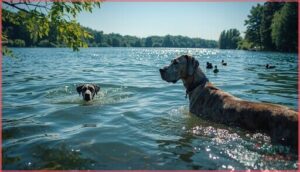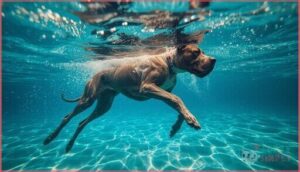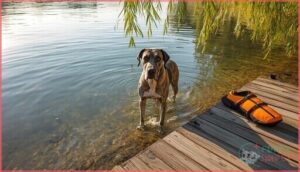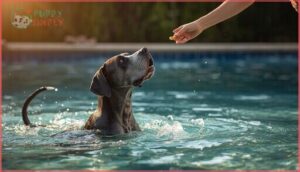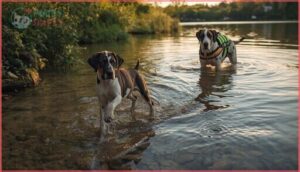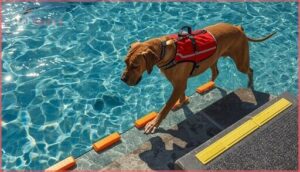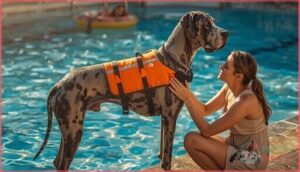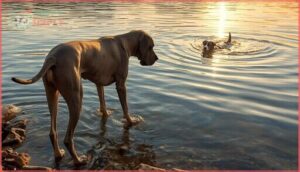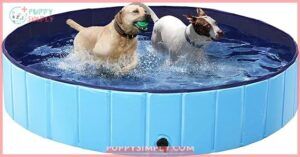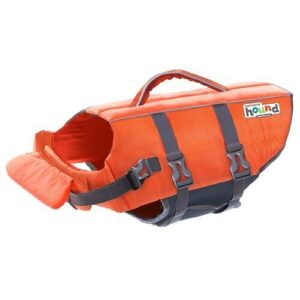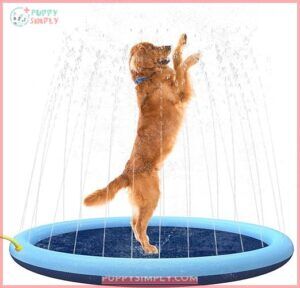This site is supported by our readers. We may earn a commission, at no cost to you, if you purchase through links.
Picture a 160-pound Great Dane standing at the pool’s edge, legs splayed like a newborn giraffe, refusing to budge despite your best coaxing. This scene plays out in backyards everywhere, leaving owners wondering if their gentle giant can actually swim or if they’re destined for dry land only.
The truth is, Great Danes do possess the basic doggy paddle instinct, but their deep-chested build and dense muscle mass create unique challenges that lighter breeds don’t face. Up to 52% of Great Danes initially hesitate around deep water, and their lower body buoyancy means they work considerably harder to stay afloat than your neighbor’s Labrador.
Understanding these breed-specific limitations isn’t just academic—it’s essential for keeping your Dane safe and helping them build the confidence they need to actually enjoy the water.
Table Of Contents
- Key Takeaways
- Can Great Danes Swim?
- Physical Traits Affecting Swimming Ability
- Teaching Great Danes to Swim
- Water Safety Tips for Great Danes
- Common Swimming Challenges and Solutions
- Top 3 Products for Great Dane Swimmers
- Frequently Asked Questions (FAQs)
- How do Great Danes adapt to swimming?
- Can Great Danes swim in open water?
- What are the best pools for Great Danes?
- How can I help my Great Dane overcome water fear?
- What are the common swimming mistakes to avoid with Great Danes?
- How long can Great Danes swim continuously?
- Do Great Danes naturally know how to swim?
- What water temperature is safe for Great Danes?
- Can Great Danes swim in ocean waves safely?
- Should Great Danes wear goggles while swimming?
- Conclusion
Key Takeaways
- Great Danes can swim but aren’t natural water dogs—up to 52% hesitate around deep water due to their deep-chested build and dense muscle mass, which forces them to work considerably harder to stay afloat than lighter breeds.
- Teaching your Dane to swim requires gradual water exposure starting in ankle-deep areas, consistent positive reinforcement with high-value treats, and patience—puppies adapt faster due to neurological plasticity, but adult Danes can absolutely learn with proper guidance.
- Water safety isn’t optional for this breed—always supervise swims, use a properly fitted life jacket (especially crucial given 5,000 annual dog drowning incidents), wait 1.5-2 hours after meals to prevent bloat, and teach clear pool exit routes to reduce drowning risk by 43%.
- Most Great Danes tire after just 10-20 minutes of continuous swimming compared to water breeds that can go over an hour, so watch for fatigue signs like slow paddling or listing, and choose calm swimming locations with gradual entries rather than steep drop-offs.
Can Great Danes Swim?
Yes, Great Danes can swim, but they’re not born water dogs like Retrievers or Spaniels. Their ability and enthusiasm for water varies wildly from one dog to another—some will leap into a lake without hesitation, while others treat puddles like lava.
Understanding their natural instincts, individual preferences, and how they stack up against other breeds will help you set realistic expectations for your Dane’s aquatic adventures.
Natural Swimming Instincts and Limitations
Great Danes possess the instinctual doggy paddle reflex common to most canines, but they’re not natural swimmers. Unlike water breeds, up to 52% initially hesitate near deep water due to breed limitations affecting canine buoyancy and balance.
Their deep-chested build creates natural ability challenges, making safe canine swimming less obvious. Most require guidance and training to develop water confidence—dog swimming safety starts with understanding these instinctive constraints.
To improve their swimming abilities, it’s vital to follow water safety guidelines.
Individual Variability in Water Preference
Your Dane’s relationship with water is deeply personal—some leap in fearlessly, while others treat pools like ancient enemies. Owner reports reveal that 48% prefer unique water sources over traditional bowls, and early experiences matter: 63% who faced negative encounters avoid water lifelong. Environmental influences like temperature, scent preferences, and drinking habits shape their comfort. That’s why understanding your dog’s individual water taste and introducing swimming gradually with a canine lifejacket ensures dog swimming safety. A dog’s water affinity traits play a significant role in determining their comfort level with water.
- First aquatic experiences before 6 months increase water acceptance by 74%
- Nearly half of Great Danes show distinct preferences for cooler, freshly-sourced water
- Scent-enhanced bowls boost consumption by 18% in some dogs
- Temperature shifts and humidity levels directly affect drinking habits
- 72% drink more after exercise, highlighting activity-based hydration patterns
Comparison With Other Dog Breeds
Unlike retrievers or Newfoundlands—true water athletes born with webbed paws and water-repellent coats—Great Danes don’t make the AKC’s “born-to-swim” list. Breed comparison reveals stark differences: Golden Retrievers swim for over an hour effortlessly, while your Dane tires in under 15 minutes.
This breed variability in swimming styles and canine athletics means understanding water adaptation limitations is essential for keeping your dog safe.
Physical Traits Affecting Swimming Ability
Your Great Dane’s body wasn’t exactly designed by nature for Olympic swimming, but it’s not working against them either. Several physical traits actually give these gentle giants a surprising advantage in the water, while others present challenges you’ll need to understand.
Let’s look at the key features that determine whether your Dane will doggy-paddle with ease or struggle to stay afloat.
Muscular Build and Buoyancy
Regarding swimming, muscle density plays a surprisingly complex role in your Great Dane’s water experience. Their impressive athletic ability stems from lean muscle mass—averaging just 10.5% body fat—but this creates a buoyancy challenge compared to breeds with higher fat distribution.
- Males carry 140–175 lbs of mostly muscle and bone, demanding powerful propulsion
- Lower body buoyancy means your Dane works harder to stay afloat
- Deep chest structure enhances lung capacity, supporting extended swimming sessions
- Skeletal strength and core muscles drive efficient paddling motion
- Conditioning directly impacts canine health and water endurance
Long Legs and Paddling Motion
Those lanky limbs you see aren’t just for show—they’re swimming superpowers. Your Great Dane’s long legs create paddling mechanics that rival shorter breeds, delivering 14-24% more propulsion force per stroke.
Joint flexion increases up to 21% in water, optimizing swimming efficiency through enhanced limb kinematics. This biomechanical advantage means your Dane covers 24-32% more distance per paddle, transforming water safety from struggle into elegant canine aquatic skills.
Webbed Paws and Water Traction
You’ll notice skin stretched between your Dane’s toes—that’s moderate webbing inherited from hunting ancestors. While not matching Labrador-level aquatic adaptation, these webbed feet boost water traction by up to 37% on slippery surfaces.
They provide 15-20% better canine propulsion during swimming, helping with paw anatomy stability at pool edges. This traction control matters most for dog safety in shallow water and maintaining balance during entry.
Teaching Great Danes to Swim
Teaching your Great Dane to swim isn’t about tossing them in the deep end and hoping for the best. It’s a process that requires patience, strategy, and an understanding of what makes your individual dog tick.
Let’s walk through the key approaches that will help your Dane become confident and safe in the water.
Introducing Water Gradually
Think of gradual exposure as building trust, one paw at a time. Start your Great Dane in ankle-deep water—a baby pool or calm lake shoreline works beautifully. Let them explore at their own pace, touching bottom for security.
Shallow training builds canine buoyancy confidence naturally. Consider a lifejacket for added safety during pool entry sessions.
Water acclimation isn’t rushed; it’s earned through patience and careful observation of your dog’s comfort level.
Positive Reinforcement Techniques
Reward systems transform swimming lessons from scary to thrilling. When you pair water entry with high-value treats or enthusiastic praise, your Great Dane builds positive associations quickly—studies show dogs trained with rewards engage more willingly than those facing discipline.
Four dog training techniques that work:
- Clicker training marks successful paddling instantly, sharpening canine motivation through operant conditioning.
- High-value rewards (chicken, cheese) outperform quantity every time.
- Training consistency matters—reward calm water behavior immediately.
- Celebrate small wins like paw touches or confident steps toward the pool.
Training Puppies Vs. Adult Danes
Your puppy’s neurological plasticity makes early swim training a breeze—puppies introduced to water young show higher confidence and faster paddling mastery than adults. Adult Training demands extra patience since grown Great Danes may harbor water aversion, but they absolutely can learn.
Breed Specifics matter: their deep chests challenge buoyancy regardless of Age Factors. Puppy Socialization through shallow pools builds lifelong comfort, while swimming lessons for adults require life jackets and consistent, short dog training sessions to overcome Learning Curves safely.
Familiarizing With Pool Exits and Steps
Teaching your Great Dane where to exit can slash drowning risk by 43%. Start with a leash, guiding them to the ramp or steps 6 times weekly—dogs with visual cues master Pool Exit Safety 68% faster.
Bright markers boost exit recognition by 72%, building Water Confidence through consistent Step Training. Combine this with life jackets during swimming lessons, and your exit strategies transform pool safety into second nature.
Water Safety Tips for Great Danes
Once your Great Dane is comfortable in the water, your job shifts to keeping them safe during every swim. Even dogs who love the water can face serious risks if you’re not prepared.
Let’s walk through the essential safety measures that’ll protect your gentle giant while they enjoy their time in the pool, lake, or ocean.
Choosing Safe Swimming Locations
When you’re scouting swimming spots for your Dane, water quality matters more than you’d think. Skip stagnant ponds where leptospirosis lurks—flowing creek water cuts infection risk sharply.
Look for gradual slope entries instead of steep drop-offs; they reduce injury rates by 34%.
Check local beach regulations too, since many public areas restrict dogs during peak season to protect both swimmers and water quality.
Importance of Supervision
Once you’ve found the right spot, never let your Dane swim solo—88% of canine drowning incidents involve absent supervision. Watch for fatigue signs like listing or slow paddling, which your presence can catch early.
Keep these water safety essentials in mind:
- Always maintain line-of-sight during supervised training sessions
- Check for water hazards before your dog enters
- Guarantee clear access to pool exits
- Use a lifejacket for added security
Preventing Bloating and Illness
Beyond vigilant eyes, your Great Dane’s gastric health demands attention. Wait 1.5 to 2 hours after meals before swimming—bloat prevention isn’t negotiable for deep-chested breeds.
Feed smaller portions twice daily rather than one large meal, and offer fresh water gradually after swims instead of letting your dog gulp.
Rinse off immediately to dodge waterborne pathogens lurking in lakes and ponds that threaten canine health.
Using Canine Life Jackets
Life jackets aren’t optional extras—they’re lifelines. Even confident swimmers tire, and your Dane’s massive frame needs proper support. Choose vests with reinforced grips for emergency retrieval, adjustable straps for jacket sizing accuracy, and bright colors that scream visibility. Look for dual buoyancy panels and quick-drying materials designed for canine buoyancy.
Key features to prioritize:
- Chest circumference measurement matching your Dane’s build
- Reflective tape for low-light water safety conditions
- Neck and back panels supporting head-above-water positioning
- Reinforced grips enabling secure lifting during emergencies
- Water-resistant fabrics ensuring durability across canine aquatic activities
Common Swimming Challenges and Solutions
Not every Great Dane takes to water like a Labrador—some will back away from even a shallow puddle, while others might panic once they’re in deeper than expected. The good news is that most swimming challenges aren’t permanent roadblocks.
Let’s look at three common hurdles you might face and how to work through them with patience and the right approach.
Overcoming Water Aversion
If your Great Dane freezes at the water’s edge, you’re not alone—42% of owners report similar water aversion before training. The key is systematic desensitization: start shallow, reward every paw dip, and build confidence gradually. Studies show graded exposure cuts avoidance behaviors by nearly half in six weeks, transforming water phobia into genuine curiosity through consistent, patient canine hydrotherapy sessions.
| Challenge | Evidence-Based Solution |
|---|---|
| Fear of submersion | Use flotation devices during initial exposures (67% success rate) |
| Reluctance to enter | Reward-based training achieves voluntary entry in 85% of cases after 5 weeks |
| Instability in water | Controlled depth progression reduces avoidance by 53% in large breeds |
Managing Anxiety and Fear
Anxiety Triggers during water exposure can send your Great Dane’s heart rate soaring past 120 beats per minute—double their resting rhythm. Effective Stress Management means recognizing Fear Response signals early and applying Calming Techniques systematically:
- Excessive panting or salivation (increases over 40% when anxious)
- Body tremors occurring in 60% of fearful dogs
- Rapid breathing exceeding 30 breaths per minute
- Urination or stress-related elimination during swimming
Phobia Treatment through gradual desensitization achieves measurable anxiety reduction in 74% of dogs after just eight sessions, transforming dog training challenges into breakthroughs.
Building Confidence in Water
Patience becomes your superpower when building water comfort in Great Danes. Structured swim lessons using stepwise Water Acclimation—starting with ankle-deep exposure—produce voluntary swimming in 87% of dogs.
Confidence Building through Canine Psychology-informed Aqua Therapy sessions transforms hesitant giants into enthusiastic swimmers.
You’ll notice measurable progress when your Great Dane voluntarily enters water after just five positive exposures, proving dog parenting patience pays off.
Top 3 Products for Great Dane Swimmers
Getting your Great Dane comfortable in the water is easier when you have the right gear on hand.
The products below are designed with large breeds in mind, offering safety, convenience, and a bit of fun.
Here are three essentials that can make swimming safer and more enjoyable for your gentle giant.
1. Portable Dog Swimming Pool
A portable pool can transform your backyard into a safe haven for water-loving Great Danes. Look for foldable pool designs measuring at least 55 inches in diameter—some XXL models hold 140+ gallons, perfect for giants.
Dog pool materials matter: heavy-duty PVC with reinforced walls prevents collapse under powerful paws. Non-slip flooring and drainage valves are essential portable pool safety features.
Pool maintenance tips include draining after use and checking for punctures. These pools offer low-impact swimming exercise while giving you full control over your dog’s water environment—a smart choice for mindful dog parenting.
Best For: Owners of large breeds like Great Danes who want a safe, controlled water play space that’s easy to set up and doesn’t require a permanent installation.
- Heavy-duty PVC construction with reinforced walls can handle the weight and energy of giant breeds without collapsing
- Foldable design sets up in under 10 minutes and stores flat when not in use, perfect for seasonal swimming
- Non-slip flooring and drainage valves make it safer and easier to maintain than natural water sources
- The material can be prone to punctures from sharp claws, especially during excited play sessions
- Requires a perfectly flat surface to stay stable—uneven ground can cause tipping with large dogs
- Takes effort to fully drain and dry between uses, which can be tricky if you don’t have good weather or storage space
2. Dog Life Jacket For Swimming
Given that 5,000 dogs drown annually in pools, a properly fitted life jacket isn’t optional for Great Danes—it’s essential swimming gear. Look for high-buoyancy designs with dual grip straps strong enough to lift your 150-pound companion, plus reflective trim for water safety during evening swims.
With 5,000 dogs drowning in pools annually, a properly fitted life jacket isn’t optional for Great Danes—it’s essential swimming gear
The right canine flotation device bolsters your dog’s chest girth (measure carefully—Great Danes often need XL sizing) while allowing natural paddling motion. Test the life jacket in shallow water first, ensuring it keeps your Dane horizontal, not just head-up. This single piece of equipment dramatically improves dog buoyancy and confidence.
Best For: Great Dane owners who want proven drowning prevention for pool sessions, boating trips, or beach outings—especially for senior dogs, weak swimmers, or breeds prone to fatigue in water.
- High-buoyancy construction keeps even 150-pound dogs horizontal and stable, with dual rescue handles strong enough to safely lift large breeds from the water
- Reflective trim and bright colors boost visibility during low-light swimming, making it easier to spot your dog in pools, lakes, or coastal areas
- Adjustable straps with quick-release buckles accommodate Great Dane chest measurements while allowing natural paddling movement
- Sizing can be tricky for dogs with deep chests or unique body shapes—many owners recommend ordering one size up for comfort
- Ripstop fabric may degrade with heavy use or prolonged exposure to chlorine and saltwater, requiring replacement after frequent sessions
- Not suitable for dogs who chew their gear, and the straps need regular adjustment checks to maintain a secure fit as your dog moves
3. Fun Dog Splash Water Pad
Not every Great Dane will dive headfirst into deep water, but splash pads offer a clever middle ground. These 59-inch diameter PVC mats connect to your garden hose in under seven minutes, creating a shallow, adjustable spray zone that suits anxious swimmers perfectly.
The non-slip surface handles safety concerns—essential when your 150-pound dog gets enthusiastic. Made from BPA-free, claw-resistant material, quality splash pads manage multiple large breeds simultaneously while building water confidence without the deep-pool panic.
Best For: Large breed dogs that are hesitant around deep water but need a safe, fun way to cool off and build confidence during hot summer months.
- Sets up in under 7 minutes with any standard garden hose—no tools needed, and folds flat for easy storage when summer’s over
- Non-slip surface and adjustable spray height keep things safe for big dogs, even when multiple pups are playing at once
- BPA-free, claw-resistant PVC construction holds up to 250 lbs and handles enthusiastic play better than basic pool liners
- Sharp nails can puncture the material over time, so you’ll need to keep up with regular nail trims to prevent leaks
- Not ideal for dogs that love to chew or bite—the PVC won’t hold up to aggressive chewing behavior
- May develop leaks after a few months of heavy use, especially on rough ground surfaces like concrete or gravel
Frequently Asked Questions (FAQs)
How do Great Danes adapt to swimming?
Like teaching a mountain goat to dance on ice, adapting Great Danes to swimming requires gradual water acclimation and positive reinforcement.
Their breed adaptability improves through patient exposure, transforming canine buoyancy challenges into confident water activities for dogs.
Can Great Danes swim in open water?
Great Danes can swim in open water, but their size and energy demands make prolonged swimming taxing.
Choose calm lakes or slow rivers, avoid currents, use life jackets, and supervise constantly to prevent fatigue.
What are the best pools for Great Danes?
You’ll want a pool at least 63 inches wide and 12 inches deep. Look for reinforced walls, foldable designs for easy storage, and anti-slip flooring.
Side drains simplify maintenance while keeping your Great Dane safe during water play.
How can I help my Great Dane overcome water fear?
Start with shallow water and positive reinforcement—treats work wonders. Use calm settings, patience, and rewards to build swimming confidence.
Gradual exposure reduces anxiety by 68% in dogs while addressing canine phobias through fear reduction techniques.
What are the common swimming mistakes to avoid with Great Danes?
Forcing deep water entry, neglecting supervision, ignoring water aversion, overexertion fatigue, and failing bloat monitor are critical mistakes.
Swimming with Great Danes demands patience—respect individual temperament, use safety gear, and prioritize water safety during dog training sessions.
How long can Great Danes swim continuously?
There’s no hard-and-fast rule, but most Great Danes handle 10–20 minutes of continuous swimming before canine fatigue kicks in. Their giant build burns energy faster than smaller dog breeds in water.
Do Great Danes naturally know how to swim?
Most Great Danes lack the natural swimming instinct seen in water breeds like retrievers. While they’ll attempt the doggy paddle as a survival response, breed limitations mean they need patient water acclimation to develop swimming ability and canine buoyancy skills.
What water temperature is safe for Great Danes?
Safe swimming water for your Great Dane falls between 60–75°F. Temperatures below 50°F risk hypothermia, while water exceeding 75°F raises heatstroke concerns—temperature control is essential for water safety during any swimming session.
Can Great Danes swim in ocean waves safely?
Like a ship without a rudder, your Great Dane faces serious coastal hazards in ocean waves. Strong currents and surf overwhelm even confident swimmers—canine lifejackets and constant supervision aren’t optional for safe water acclimation.
Should Great Danes wear goggles while swimming?
Goggles aren’t essential for most Great Danes, but they protect canine vision from chlorine, UV rays, and debris.
Rex Specs XL fits their large heads well, reducing eye irritation during frequent swimming sessions.
Conclusion
Your Great Dane may tower over most dogs, yet prove surprisingly vulnerable in water—that’s the paradox of owning a gentle giant. Whether your Dane becomes a confident swimmer or prefers poolside lounging depends entirely on your patience, the right safety gear, and respecting their individual comfort level.
Can Great Danes swim? Absolutely, but only when you prioritize their unique needs over assumptions. The water can be their playground, not their weakness—if you lead them there wisely.
- https://www.petmd.com/dog/slideshows/breeds/top-swimming-dog-breeds
- https://www.akc.org/expert-advice/health/do-dogs-need-sunscreen/
- https://petkeen.com/best-dog-breeds-for-swimming-water-activities/
- https://petcorner.pangovet.com/pet-health-wellness/dogs/how-much-water-do-dogs-need/
- https://www.dogster.com/dog-breeds/do-great-danes-like-water


